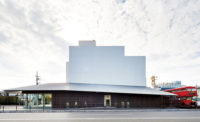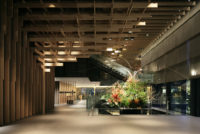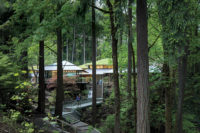Ginzan Onsen Fujiya by Kengo Kuma and Associates
Yamagata, Japan

Photo © Daici Ano

Photo © Daici Ano

Photo © Daici Ano

Photo © Daici Ano

Photo © Daici Ano

Photo © Daici Ano

Photo © Daici Ano

Image courtesy Kengo Kuma & Associates








Architects & Firms
Just as gene splicing raises controversies in the field of biology, experiments in recombinant architecture pose both practical and philosophical dilemmas. In reconfiguring a hundred-year-old onsen (hot spring hotel) in Japan’s snow country, architect Kengo Kuma raises such issues, grafting modern elements onto historic roots and giving traditional design strategies contemporary interpretations. While strict preservationists may argue with his hybrid approach to history and construction, Kuma fuses eras in a manner that is simultaneously radical and subtle.
Additional Content:
Jump to credits & specifications
Nestled at the bottom of a narrow valley in Yamagata Prefecture on the main island of Honshu, the Ginzan Onsen Fujiya stands shoulder-to-shoulder with 13 other inns facing the Ginzan River. Although most of the buildings have been altered over time, they still form a historic ensemble with powerful appeal to tourists and television crews (the popular 1983 Japanese series Oshin was shot here). So breaking ranks with the scale or massing of its neighbors was out of the question.
“We wanted to retain the continuity of the old facade while introducing a new spirit and modern amenities,” explains Kuma. To do so, the architect took apart the existing building, then reassembled it using old and new wood members. He kept the original silhouette and traditional Japanese post-and-beam construction, but inserted larger, wood-framed windows and a new sliding glass entry wall. “The idea was to connect the street with the lobby inside,” says Kuma. “So we established a new sense of transparency.”
Recessed beneath sloping wooden eaves and set behind a pair of reflecting pools, the entry wall reveals a materiality that hints at the era-blending design within. Here, Kuma employed a centuries-old, hand-blown-glass technique from France called dalle de verre. The vitreous panels, set within a steel-frame, create a slightly mottled, subtly stained greenish-blue surface that infuses the lobby with an almost aqueous character. And instead of welcoming guests into a low-ceiling reception space (as is customary in Japanese inns), he wows them with a two-story-high atrium furnished with modern tables, chairs, and sofas that he designed with a Zen-like simplicity of form.
Layering space with screens is a traditional Japanese device, but Kuma imbues it with an inventive spirit by choreographing a sequence of entry rooms divided by veil-like walls of remarkable materials.
CreditsOwner: Architect: Principal in charge: Project Architect: Engineer(s): Consultant(s): General contractor: Photographers: |
ProductsExterior Cladding: Roofing: Glazing: Doors: Wood doors: wooden flash door Sliding doors: wooden flash door Upswinging doors, other: wooden flash door Hardware: Cabinet hardware: special order Interior finishes: Cabinetwork and custom woodwork: elm Paints and stains: Acrylic emulsion paint, Urethane clear paint Wallcoverings: Japanese rice paper Floor and wall tile: coral gray stone Furnishings: Fixed seating: Tables: Tendo Mokko: steel frame 10x10 phosphoric acid treated Lighting: Conveyance: Plumbing: Shower: Fantini Sink: Agape and Toto Faucet: Cera and Advan. (‘onsen’ faucets are custom) Add any additional building components or special equipment that made a significant contribution to this project: Stained glass: PEINTRE VERRIER Masato Shida
|














